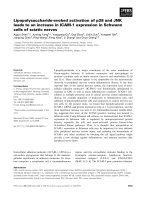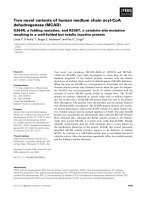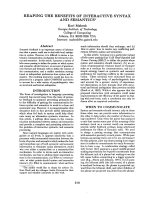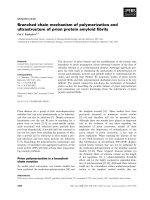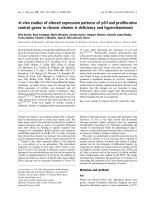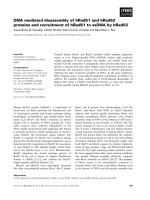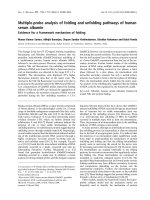Báo cáo khoa học: In vivo studies of altered expression patterns of p53 and proliferative control genes in chronic vitamin A deficiency and hypervitaminosis pot
Bạn đang xem bản rút gọn của tài liệu. Xem và tải ngay bản đầy đủ của tài liệu tại đây (257.25 KB, 9 trang )
In vivo
studies of altered expression patterns of
p53
and proliferative
control genes in chronic vitamin A deficiency and hypervitaminosis
Elisa Borra
´
s, Rosa Zaragoza
´
, Marı
´
a Morante, Concha Garcı
´
a, Amparo Gimeno, Gerardo Lo
´
pez-Rodas,
Teresa Barber, Vicente J. Miralles, Juan R. Vin
˜
a and Luis Torres
1
Departamento de Bioquı
´
mica y Biologı
´
a Molecular, Facultades de Medicina y Farmacia., Universidad de Valencia, Valencia, Spain
Several clinical trials have revealed that individuals who were
given b)carotene and vitamin A did not have a reduced risk
of cancer compared to those given placebo
2,3
;
2,3
rather, vita-
min A could actually have caused an adverse effect in the
lungs of smokers [Omenn, G.S., Goodman, G.E., Thorn-
quist, M.D., Balmes, J., Cullen, M.R., Glass, A., Keogh,
J.P., Meyskens, F.L., Valanis, B., Williams, J.H., Barnhart,
S. & Hammar, S. N. Engl. J. Med (1996) 334, 1150–1155;
Hennekens, C.H., Buring, J.E., Manson, J.E., Stampfer, M.,
Rosner,B.,Cook,N.R.,Belanger,C.,LaMotte,F.,Gazi-
ano, J.M., Ridker, P.M., Willet, W. & Peto, R. (1996)
N.Engl.J.Med. 334, 1145–1149]. Using differential display
techniques, an initial survey using rats
4
showed that liver
RNA expression of c-H-Ras was decreased and p53
increased in rats with chronic vitamin A deficiency
5
.These
findings prompted us to evaluate the expression of c-Jun, p53
and p21
WAF1/CIF1
(by RT-PCR) in liver and lung of rats. This
study showed that c-Jun levels were lower and that p53 and
p21
WAF1/CIF1
levels were higher in chronic vitamin A
deficiency. Vitamin A supplementation increased expression
of c-Jun, while decreasing the expression of p53 and
p21
WAF1/CIF1
. Western-blot analysis demonstrated that
c-Jun and p53 showed a similar pattern to that found in the
RT-PCR analyses. Binding of retinoic acid receptors (RAR)
to the c-Jun promoter was decreased in chronic vitamin A
deficiency when compared to control hepatocytes, but
contrasting results were found with acute vitamin A sup-
plementated cells. DNA fragmentation and cytochrome c
release from mitochondria were analyzed and no changes
were found. In lung, an increase in the expression of c-Jun
produced a significant increase in cyclin D1 expression.
These results may explain, at least in part, the conflicting
results found in patients supplemented with vitamin A and
illustrate that the changes are not restricted to lung.
Furthermore, these results suggest that pharmacological
vitamin A supplementation may increase the risk of adverse
effects including the risk of oncogenesis.
Keywords: vitamin A; retinoic acid; p53; cyclin D1; c-Jun
6
.
Vitamin A (retinol) is an essential nutrient that is metabo-
lized in mammalian cells to retinal and retinoic acid. The
latter shares some of the activities of retinol but is unable to
support processes such as vision (11-cis-retinal). Retinoids
exert their effects by binding to specific receptors that
comprise two subfamilies, RARs (retinoic acid receptors)
and RXRs (retinoid X/cis RAR) [1,2]. A variety of studies
have shown that vitamin A is necessary for normal growth
and development through control of gene expression [3–9].
Vitamin A has other important effects; it can function
as a pro-oxidant or as an antioxidant. The antioxidant
properties of vitamin A have been shown both in vitro
and in vivo [10–12]. Vitamin A deficiency causes oxidative
damage to liver mitochondria in rats that can be reversed by
vitamin A supplementation [13]. However, the addition of
retinol and retinal to cultures of HL-60 cells causes cellular
DNA cleavage and an increased formation of 8-oxo-7,8-
dihydro-2¢-deoxyguanosine via superoxide generation [14];
moreover, in vitro, it has been shown that b-carotene
cleavage products induce oxidative stress by impairing
mitochondrial respiration [15]. Therefore, maintaining the
vitamin A concentration within the physiological range is
critical to normal cell function because either a deficiency or
an excess of vitamin A induces oxidative stress.
This study was undertaken to identify genes that may be
regulated by vitamin A. Liver and lung were evaluated in
normal, chronic vitamin A deficient and vitamin A supple-
mented rats by the technique of differential display. As
expression of c-H-Ras was found to be lower and that of p53
7
was higher in chronic vitamin A deficiency and c-H-Ras and
p53 play an inverse role in the control of cellular prolifer-
ation, related genes were studied by RT-PCR. The results
presented here emphasize the importance of vitamin A in
controlling the expression of p53 and related genes that are
essential for maintaining the integrity of tissues.
Materials and methods
Rats
Wistar rats (Charles River Lab., Barcelona, Spain)
8,9,10
were
given a vitamin A deficient, solid diet
8,9,10
.
8,9,10
Pregnant rats were
housed in individual cages in a room maintained at 22 °C
Correspondence to J. R. Vin
˜
a, Departamento de Bioquı
´
mica y
Biologı
´
a Molecular, Facultad de Medicina, Universidad de
Valencia, Avenue. Blasco Iban
˜
ez 17, Valencia-46010, Spain.
E-mail:
Abbreviations: RAR, retinoic acid receptors.
(Received 24 October 2002, revised 14 January 2003,
accepted 20 January 2003)
Eur. J. Biochem. 270, 1493–1501 (2003) Ó FEBS 2003 doi:10.1046/j.1432-1033.2003.03511.x
with a 12-h light : 12-h dark cycle. Rats were cared and
handled in conformence with the Guiding Principles for
Research Involving Animals and Humans, approved by the
Council of the American Physiological Soceity. The School
of Medicine Research Committee approved this study. One
day after pup birth, dams were fed either a control diet or
vitamin A-deficient diet. Milk production was evaluated
during lactation in both groups. After weaning, the rats
were fed the same corresponding diet until 50 days old [13].
A third group of rats received a daily peritoneal injection of
vitamin A (200 000 IU all trans-retinol palmitate per kg
body weight) over a period of 5 days.
The trans-retinol palmitate (type VII: synthetic Sigma)
was dissolved in NaCl 0.15
M
. The control rats for the latter
group were injected with NaCl, 0.15
M
over a period of
5days.
Retinoid determination
The experiments were performed between 10.00 h and
12.00 h. Rats were anesthetized with Pentothal (50 mgÆkg
)1
body weight, intraperitoneally). Blood was collected from
the aorta in heparinized syringes and then liver and lung
samples were taken and processed immediately.
Retinol and retinyl palmitate were measured in serum
and tissues following the method described by Barua and
Olson [16].
Differential display analysis
Liver RNA was isolated by extraction with the guanidinium
thiocyanate method followed by centrifugation in a cesium
chloride solution as described previously [17]. A 25-lg
amount of total RNA was incubated for 30 min at 37 °C
with 10 U of Dnase I/RNase-free (Roche Molecular Bio-
chemicals) in 10 m
M
Tris/HCl pH 7.5, 10 m
M
MgCl
2
,then
samples were phenol/chloroform (1/1)
11
extracted and etha-
nol precipitated in the presence of 0.3
M
sodium acetate.
RNA was redissolved in sterile nuclease-free water.
Differential display was performed using oligo(dT)
anchored primers [17,18] with the Hieroglyph mRNA
Profile Kit (Genomyx, Beckman Instruments, Fullerton,
CA, USA) following the manufacturer’s instructions with
some modifications. First strand cDNA synthesis was
performed with 2 lL of DNase-treated total RNA
(0.1 lgÆlL
)1
), 2 lL of oligo(dT) anchored primer (2 l
M
)
and 2 lLdNTPmix(250l
M
) (1 : 1 : 1 : 1) (v/v/v/v)
12
using
SuperScript
TM
RNase H–Reverse Transcriptase (Gibco-
BRL Life Technologies) in 50 m
M
Tris/HCl pH 8.3, 75 m
M
KCl, 20 m
M
dithiothreitol in a Perkin-Elmer Gene-
Amp 9700 thermal cycler at 25 °C(10min),50°C
(60 min) and 70 °C (15 min). The PCR was started by
adding 2 lL of the cDNA solution to a mixture containing
9.95 lL of sterile nuclease-free water, 1.2 lLMgCl
2
(25 m
M
), 1.6 lLdNTPmix(250l
M
)(1:1:1:1)(v/v/v)
(Roche Molecular Biochemicals), 2 lL5¢-arbitrary primer
(2 m
M
), 2 lL AmpliTaq Buffer[10 · ], 0.2 lL AmpliTaq
enzyme (5 UÆlL
)1
) (Perkin-Elmer, Branchburj, NJ, USA),
and 0.25 lL[a-
33
P]dATP (10 lCiÆlL
)1
). Thermal cycling
parameters using a GeneAmp 9700 thermal cycler were as
follows: 95 °C (2 min), four cycles at 92 °C(15s),50°C
(30 s) and 72 °C (2 min), 30 cycles at 92 °C(15s),60°C
(30 s), and 72 °C (2 min), and an additional final extension
step at 72 °C for 7 min. Reactions were performed with
each cDNA solution in duplicate. Control reactions were set
using sterile nuclease-free water or each DNase I-treated
RNA instead of the cDNA solution.
Following differential display PCR, radiolabeled cDNA
fragments were electrophoretically separated on 4.5%
polyacrylamide gels under denaturing conditions in a
Genomix LR DNA sequencer (Genomix, Beckman). Gels
were dried and exposed to produce an autoradiograph.
Bands of interest were excised from the gel, and the gel
slides were placed directly into PCR tubes and covered with
40 lL of PCR mix (24.4 lL sterile nuclease-free water,
3.2 lLdNTPmix,4lL T7 promoter 22-mer primer
(2 l
M
), 4 lL M13 reverse 24-mer primer (2 l
M
), 2.4 lL
MgCl
2
(25 m
M
), 4 lL AmpliTaq PCR Buffer (10 ·), and
0.4 lL AmpliTaq enzyme (5 UÆlL
)1
). PCR was performed
as follows: 95 °C (2 min), four cycles at 92 °C(15s),50°C
(30 s) and 72 °C (2 min), 30 cycles at 92 °C(15s),60°C
(30 s), and 72 °C (2 min), and an additional extension step
at 72 °C for 7 min. Amplified fragments was sequenced in
both directions using M13 reverse (-24) primer and T7
promoter forward (-22) primer. Nucleotide sequence
homology search analysis of the EMBL [19] and GenBank
[20] databases were performed using the
BLAST
program [21].
RNA isolation and Northern blot analysis
Total RNA from the different tissues used was isolated by
the guanidinium thyocianate method [22]. Aliquots (20 lg)
of total RNA were size-fractioned by electrophoresis in a
1% agarose gel under denaturing conditions. RNAs were
then blotted and fixed to Nytran membranes (Schleicher
and Schuell, Keene, NH). Prehybridization and hybridiza-
tion were performed as described previously [23]. Probes
were the isolated clones from differential display (0.8-kb of
mRNA p53 gene and 0.9-kb of mRNA c-H-Ras gene).
Equal loading of the gels was assessed using ethidium
bromide staining of the gel. The probes were labeled with
[a
32
P]dCTP (3000 CiÆmmol
)1
) by random priming using the
rediprime
TM
II DNA labeling system (Amersham Pharma-
cia Biotech). Specific activity was 5 · 10
8
c.p.m.Ælg
)1
of
DNA. Quantitation was performed by densitometry of the
X-ray films.
Analysis of mRNA expression by RT-PCR
RT-PCR was performed in one step with an Enhanced
Avian RT-PCR Kit following the instructions of the
manufacturer (Sigma). c-Jun expression levels were deter-
mined using the following primers (5¢-TGAGTGCA
AGCGGTGTCTTA-3¢ (forward) and 5¢-TAGTGGTGA
TGTGCCCATG-3¢ (reverse); primers for p21
WAF1/CIF1
:
5¢-ACAGCGATATCGAGACACTCA-3¢ (forward) and
5¢-GTGAGACACCAGAGTGCAAGA-3¢ (reverse); pri-
mers for p53:5¢-CACAGTCGGATATGAGCATC-3¢
(forward) and 5¢-GTCGTCCAGATACTCAGCAT-3¢
(reverse) and primers for cyclin D1:5¢-TGTTCGTGGC
CTCTAAGATGA-3¢ (forward) and 5¢-GCTTGACTCCA
GAAGGGCTT-3¢ (reverse); primers for 18S rRNA:
5¢-GAGTATGGTCGCAAGGCTGAA-3¢ (forward) and
5¢-GCCTCCAGCTTCCCTACACTT-3¢ (reverse). 18S
1494 E. Borra
´
s et al. (Eur. J. Biochem. 270) Ó FEBS 2003
rRNA was simultaneously amplified and used as an internal
control. Routinely, RNA concentration curves were
performed to verify that the RT-PCR was quantitative.
Reactions were resolved using a 2% agarose gel stained with
ethidium bromide and quantified using the Gene Genius
System Tools analysis software (
SYNGENE
).
Antibodies
Monoclonal (mouse) anti-p53 was purchased from
Calbiochem (Ab-3 op29), anti-c-Jun Ig and anti-RAR
(a,b,c) Ig, were purchased from Santa Cruz Biotechnology,
Inc.
Immunoblot analysis
Tissues were homogenized in 10 mLÆg
)1
of tissue of ice-
cold buffer A [10 m
M
Hepes, pH 7.9, 10 m
M
KCl, 2 m
M
MgCl
2
,0.5m
M
dithiothreitol, 1 m
M
phenylmethane-
sulfonyl fluoride, 5 m
M
NaF, 0.5 m
M
Na
3
VO
4
and 0.1%
Triton X-100 in the presence of protease inhibitor
(5 lLÆmL
)1
P8340, Sigma)]
13
. The resulting homogenate
was centrifuged at 14 000 r.p.m.
14
for 15 min at 4 °C.
To obtain the nuclear proteins, the sediment was re-sus-
pended in 3 mLÆg
)1
of tissue in 20 m
M
Hepes pH 7.9, 25%
glycerol, 0.42
M
NaCl, 1.5 m
M
MgCl
2
,0.2m
M
EDTA,
0.5 m
M
dithiothreitol, 1 m
M
phenylmethanesulfonyl
fluoride, 5 m
M
NaF, 0.5 m
M
Na
3
VO
4
in the presence of
protease inhibitors. The suspension was incubated for
30 min on ice and centrifuged at 17 089 g
15
for 10 min, at
4 °C. The supernatant was diluted with 500 lLof20m
M
Hepes pH 7.9, 20% glycerol, 50 m
M
KCl, 1.5 m
M
MgCl
2
,
0.2 m
M
EDTA, 0.5 m
M
dithiothreitol, 0.5 m
M
phenyl-
methanesulfonyl fluoride, 5 m
M
NaF, 0.5 m
M
Na
3
VO
4
.To
obtain the cytosolic proteins, the original supernatant was
centrifuged at 15 868 g
16
for 10 min at 4 °Cinorderto
remove mitochondria.
Samples were subjected to 10% SDS/PAGE to study the
high molecular mass protein or a gradient (10–15%) SDS/
PAGE to study the low molecular mass protein. In any case,
after electrophoresis, the proteins were electroblotted onto
nitrocellulose membranes (Schleicher and Schuell). Immu-
nodetection of specific proteins was made with the respective
antibody. Blots were incubated in blocking solution (5% w/v
nonfat dry milk with 0.05% v/v Tween 20), for 1 h at room
temperature with shaking; following three washes with
TTBS (25 m
M
Tris/HCl, pH 7.5, 0.15
M
NaCl and 0.1% v/v
Tween 20), blots were incubated with primary antibodies in
TTBS for 1 h at room temperature with gentle agitation.
Blots were washed again with TTBS and incubated with the
secondary antibody conjugates to horseradish peroxidase
(Bio-Rad) for 20 min. Finally, blots were washed with TTBS
and developed with a chemiluminescence kit (Lumi-Light
Western Blotting Substrate, Roche).
Immunoprecipitation of RAR-DNA complexes (chip assay)
Liver cells were isolated from control, chronic vitamin A-
deficient and hypervitaminic rats by the method of Berry
and Friend as modified by Romero and Vin
˜
a [24]. Cells
were treated with 1% formaldehyde in Krebs–Ringer buffer
under gentle agitation for 10 min at room temperature in
order to crosslink the transcription factors to DNA. The
cells were collected by centrifugation at 190 g for 5 min,
washed twice in 40 mL of NaCl/P
i
pH 7.4, once in
solution I (10 m
M
Hepes, pH 7.5, 10 m
M
EDTA, 0.5 m
M
EGTA, 0.75% Triton X-100) and once in solution II
(10 m
M
Hepes pH 7.5, 200 m
M
NaCl, 1 m
M
EDTA,
0.5 m
M
EGTA). The cells were resuspended in 500-lLof
lysis buffer (25 m
M
Tris/HCl pH 7.5, 150 m
M
NaCl, 1%
Triton X-100, 0.1% SDS, 0.5% deoxycholate) supplemen-
tedwithproteaseinhibitorsandthensonicatedonicefor10
steps of 10 s at 30% output in a Branson 250 Sonicator
(with microtip). The samples were centrifuged at 19 000 g
for 2 min to clear the supernatants. The supernatants were
transferred to an eppendorf tube and centrifuged at
19 000 g for 10 min. The lysates were diluted tenfold in
lysis buffer and stored at )20 °C in aliquots of 1 mL
(sample named as ÔinputÕ).
The immunofractionation of RAR–DNA complexes was
performed by addition of 10 lgÆmL
)1
of RARc antibody
(Santa Cruz Biotechnology, sc-773) and incubation at 4 °C
overnight (on a 360° rotator). The inmunocomplexes were
incubated with 10 mg of protein A Sepharose, prewashed
with lysis buffer for 4 h at 4 °C under gentle rotation. The
immunocomplexes were collected by centrifugation
(6500 g, 1 min). The supernatant was stored at )20 °C.
This fraction was named the Ôunbound fractionÕ. Antibody-
bound fraction was washed once with RIPA buffer (50 m
M
Tris/HCl pH 8.0, 150 m
M
NaCl, 0.5% deoxycholate, 0.1%
SDS, 1% NP-40, 1 m
M
EDTA), once with high salt buffer
(50 m
M
Tris HCl pH 8.0, 500 m
M
NaCl, 0.1% SDS, 0.5%
deoxycholate, 1% NP-40, 1 m
M
EDTA) once with LiCl
buffer (50 m
M
Tris/HCl pH 8.0, 1 m
M
EDTA, 250 m
M
LiCl, 1% de NP-40, 0.5% deoxycholate) and twice with
Tris/EDTA
17
buffer pH 8.0. The cross-links were reversed by
heating the samples at 65 °C overnight. The DNA from all
fractions (input, bound and unbound) were extracted with
phenol/chloroform (1/1)
18
and quantified by fluorescence
with PicoGreen dye (Molecular Probes).
Analysis of immunoprecipitated DNA
To check that the immunoprecipitation contains the c-Jun
promoter among the pull of DNA, the different DNA
samples (input, bound and unbound) were analyzed
by PCR using the primers 5¢-TGTAACCTCTACTCCCA
CCCA-3¢ (forward) and 5¢-TCTGAGTCCTTATCCAGC
CTG-3¢ (reverse) corresponding to a region of the c-Jun
promoter that expands between the start transcription site
and the )504 position.
Statistics
In the experiment shown in the Table 1, a two-way
ANOVA
was performed; in the other experiments, a one-way
ANOVA
was performed. The homogeneity of the variances was
analyzed by the Levene test; in those cases in which
the variances were unequal, the data were adequately
transformed before the
ANOVA
. The null hypothesis was
accepted for all the values of these sets in which the
F-value was nonsignificant at P > 0.05. The data for which
the F-value was significant were examined by the Tukey’s
test at P < 0.05. Values in the text are means ± SEM.
Ó FEBS 2003 Vitamin A status and proliferative control genes (Eur. J. Biochem. 270) 1495
Results
Physiological parameters and all-
trans
retinol
and all-
trans
retinyl palmitate concentrations
in plasma and tissues
After delivery, dams were fed either a control diet or a
vitamin A-deficient diet for 50 days. Milk production was
evaluated at the peak of lactation in both groups, and no
difference was found. After weaning, the pups either ate the
control diet or the vitamin A-deficient diet; no statistical
difference in body weight or food intake was found between
groups. In control rats injected daily with all-trans retinyl
palmitate over a period of 5 days, food intake was also not
different from control rats.
All-trans retinol plasma concentration was decreased
significantly in chronic vitamin A deficiency when com-
pared to control rats (Table 1). In the liver of vitamin
A-deficient rats, all-trans retinol and all-trans retinyl palmi-
tate were decreased significantly when compared to control
livers. In lung from vitamin A-deficient rats, all-trans-retinyl
palmitate was decreased significantly when compared to
control lungs (Table 1). When rats were injected daily over a
period of 5 days with retinyl palmitate, the concentration of
this compound was significantly higher in plasma, liver and
lung when compared to controls.
Liver gene expression evaluated by differential display
in control and in chronic vitamin A-deficiency
Liver differential display analysis was performed in control
and chronic vitamin A-deficient rats (50 days). Several
bands were differentially expressed in chronic vitamin A-
deficiency when compared to control liver. Two of the
bands selected for analysis, whose expression were differ-
entialy expressed in chronic vitamin A-deficiency, were
excised from the gel, amplified and sequenced (Fig. 1). The
first clone of 0.8 kb had 100% homology to part of the
rat p53 cDNA and could hybridize to a 1.6-kb mRNA in
total cellular RNA from rat liver. The band detected in
Northern blot by the first clone corresponded in size to that
reported for rat p53 and was up-regulated fivefold when
compared with control rat liver, thus confirming the
up-regulation detected in the differential display gel. The
second clone of about 0.9 kb had 100% homology to part
of the rat c-H-Ras cDNA and hybridized with a 1.7-kb
mRNA in total RNA from rat liver. This gene was down-
regulated sixfold when compared with control rat liver
(Fig. 1), showing an opposite expression pattern to that of
the p53 gene.
RT-PCR analysis of
c-jun
,
p53
and
p21
WAF1/CIF1
in liver
and lung of control, chronic vitamin A-deficiency
and hypervitaminosis rats
Based on the results found in the differential display study
and taking into account the role that p53 plays in the control
of cellular proliferation, the expression levels of p53, c-Jun (a
negative regulator of p53)andp21
WAF1/CIF1
(positively
regulated by p53) were evaluated in liver by RT-PCR
analysis. The mRNA levels in liver (Fig. 2) and in lung
(Fig. 3) of p53 and of p21
WAF1/CIF1
were significantly
increased in vitamin A-deficient rats when compared to
controls but the expression of c-Jun was significantly lower
when compared to controls. When retinyl palmitate
was injected daily over a period of 5 days, the expression
levels of p53 and p21
WAF1/CIF1
were significantly lower than
in controls while the expression level of c-Jun was signifi-
cantly higher than in control (Figs 2 and 3).
Western blot analysis in liver and lung of control,
chronic vitamin A-deficiency and hypervitaminosis rats
Liver and lung samples were electrophoresed and immuno-
blotted with specific antibodies. The amount of p53 protein
was significantly higher in chronic vitamin A-deficient rats
than in controls, while the amount of c-Jun was significantly
lower in chronic vitamin A-deficiency as compared to
controls. In hypervitaminosis the amount of p53 was
significantly lower than in controls, whereas the amount
of c-Jun was significantly higher than in controls (Fig. 4).
These changes in the pattern levels followed the pattern of
p53 and c-Jun gene expression showed in Figs 2 and 3.
Immunoprecipitation of complex RAR–DNA
To elucidate the mechanism of this pattern of expression,
the binding of RAR to c-Jun promoter was studied using
the immunoprecipitation of complex RAR–DNA with a
polyclonal antibody reactive to RARa,RARb and RARc.
Table 1. Retinol concentrations in plasma and tissues from control, vitamin-A deficient and hypervitaminosis rats. Values are means ± SEM, with the
numbers of animals indicated in parentheses. Different superscript letters within a row indicate significant differences, P <0.05.ND,notdetected.
Control Vitamin A-deficient Hypervitaminosis
PLASMA (l
M
)
All-trans retinol 2.99 ± 0.48 (6)
a
0.46 ± 0.10 (4)
c
1.61 ± 0.12 (5)
b
All-trans retinyl palmitate ND ND 1.60 ± 0.22 (5)
TISSUES (lg/g)
Liver
All–trans retinol 2.88 ± 0.48 (6)
b
0.18 ± 0.03 (2)
c
78.08 ± 15.40 (3)
a
All–trans retinyl palmitate 64.66 ± 10.97(6)
b
5.60 ± 1.66 (4)
c
4276 ± 1334 (5)
a
Lung
All–trans retinol 0.23 ± 0.02 (3)
b
ND 44.14 ± 6.05 (5)
a
All–trans retinyl palmitate 2.99 ± 0.32 (4)
b
0.64 ± 0.11 (4)
c
262.74 ± 35.55 (5)
a
1496 E. Borra
´
s et al. (Eur. J. Biochem. 270) Ó FEBS 2003
DNA was extracted from the input, bound and unbound
fractions; equal amounts from each fraction were analyzed
using primers that amplify the c-Jun promoter region
between the start transcription site and the )504 position.
The amplified DNA was resolved by agarose gel electro-
phoresis. The specific binding was determined by the relative
intensity of ethidium bromide fluorescence when compared
to the input control. Our data show that the RAR binding
was almost undetectable in vitamin A-deficiency when
compared to controls, while in acute hypervitaminosis
the binding was significantly higher. These changes in the
RAR–DNA binding is not due to different levels of the
retinoic acid receptor induced by the treatment, as RAR
expression was similar in control, vitamin A-deficiency and
hypervitaminosis (Fig. 5) rats. An antibody against a
protein unrelated to vitamin A was used as a mock control
and binding was not observed (results not shown).
Discussion
Using differential display analysis, it has been shown in the
liver of chronic-vitamin A deficient rats that the expression
of p53 was significantly higher when compared to control
rats. It was also found that expression of c-H-Ras was
significantly lower in chronic vitamin A-deficient rats than
in controls. Based on these findings, c-Jun, a proto-oncogene,
that encodes a component of the mitogen-inducible
immediate early transcription factor, AP-1 and has that
been implicated as a positive regulator of cell proliferation
Fig. 2. Expression of c-Jun, p5 3 and p21
WAF1/CIF1
in liver. (C) control
rats (D) vitamin A-deficient and (H) hypervitaminosis. Total RNA
was isolated for each condition amplified by RT-PCR using specific
primers for p53, c-Jun, p21 and for 18S rRNA as described in Mate-
rials and methods. *P < 0.05.
Fig. 1. Detection of differential gene expression induced by chronic
vitamin A-deficiency in rats. Panel A, sequencing gel electrophoresis of
PCR amplified cDNAs performed in duplicate, from control (C) and
vitamin A-deficient rats (D). A differentially displayed fragment
(arrow) was detected, isolated, and identified as a 0.8-kb fragment of
p53 cDNA. Northern blot analysis of total RNA from control and
vitamin A-deficient rats with p53 cDNA fragment confirmed its dif-
ferential expression. Panel B, another differentially displayed fragment
was detected, isolated and identified as a 0.9-kb fragment of c-H-Ras
cDNA. Northern blot analysis of total RNA confirmed its differential
expression.
Ó FEBS 2003 Vitamin A status and proliferative control genes (Eur. J. Biochem. 270) 1497
and G
1
–S phase progression [24,26], was analyzed by
RT-PCR. As expected, in chronic-vitamin A-deficiency,
c-Jun was significantly lower than in control animals as
it negatively regulates transcription of p53 by binding
directly to a variant AP1 site in the p53 promoter [25]. As
p21
WAF1/CIP1
encodes a cyclin dependent kinase inhibitor
that is a critical target of p53 in facilitating G
1
arrest, we also
studied the expression of p21
WAF1/CIP1
, and found that it is
increased in chronic-vitamin A deficiency when compared
to control rats. Using Western blot analysis it was also
found that p53 protein was increased and c-Jun protein was
decreased in liver chronic-vitamin A deficient rats when
compared to controls. No apoptosis was found in liver of
chronic-vitamin A deficiency because the typical ladder-
type DNA pattern of nuclear apoptosis was not observed
and also no cytochrome c was detected in the cytosol (data
not shown). All these results found in chronic vitamin A
deficient rats suggest that the increase of p53,resultsin
arrest of progression through the cell cycle [27]. In rats
Fig. 4. Western blot analysis of p53 and c-Jun in liver and lung. Total
protein extracts were obtained as described in experimental proce-
dures. A single band of about 53 kDa was detected in liver and lung
indicating that the amount of p53 protein was significantly increased in
the liver and lung from vitamin A-deficient rats that in controls. c-Jun
protein was significantly decreased in vitamin A-deficient rats. In the
liver of rats with hypervitaminosis the results showed a decrease in
theamountofp53andanincreaseofthec-Jun.Thefigureshows
that the expression of p53 is time course dependent. C, control; D,
vitamin A-deficient rats; H, hypervitaminosis.
Fig. 3. Expression of c-Jun, p53 and p21
WAF1/CIF1
in lung. (C) control
rats (D) vitamin A-deficient rats (H) hypervitaminosis. Total RNA
was isolated for each condition amplified by RT-PCR using specific
primers for p53, c-Jun, p21 and for 18S rRNA as described in Mate-
rials and methods. *P < 0.05.
1498 E. Borra
´
s et al. (Eur. J. Biochem. 270) Ó FEBS 2003
injected with a high-dose of vitamin A over a period of
5days,c-jun was increased and p53 and p21
WAF1/CIP1
were
significantly lower when compared to controls.
Overexpression of c-Jun alters cell cycle parameters and
increases the proportion of cells in S, G
2
and M relative to
G
0
phases of the cell cycle. The role of c-Jun in promoting
cell growth has been highlighted from studies of c-Jun
deficient mouse embryonic fibroblasts [27]. Fibroblasts
lacking c-Jun exhibit a severe proliferation defect, because
these cells accumulate the tumor suppressor, p53 and its
downstream target, the cyclin-dependent kinase inhibitor
p21
WAF1/CIF1
, suggesting that one particular function of
c-Jun is the negative regulation of p53 transcription. The
fact that the binding of RAR to the c-Jun promoter is
affected by the vitamin A status and that no changes in the
RAR amount were observed, suggests that c-Jun is under
direct control of retinoic acid. However, c-Jun expression
can be also regulated by Ras by means of the MAPkinase
pathway [28] and this mechanism could explain in part
the decreased expression of c-Jun found in chronic-
vitamin A-deficient rats
19
. The molecular mechanism that
explains the decrease in C-H-Ras expression found in
chronic-vitamin A deficient rats is unknown at the present
time.
The role of vitamin A status in the expression of genes
related to the regulation of cell proliferation has been
studied in vivo and in vitro, and shows that retinoids play an
important role in proliferation and differentiation. Using
mice deficient in retinaldehyde dehydrogenase-2 it has been
shown that retinoic acid synthesized by the postimplanta-
tion mammalian embryo is an essential developmental
hormone whose absence leads to early embryonic death [7].
In rat Sertoli cells, a significant up-regulation in c-Jun
(beginning at 30 min and reaching a fourfold peak over
controls at 1 h) has been observed [9]. Our results, in an
in vivo model, are in agreement with these observations
because c-Jun, p53 and p21
WAF1/CIF1
are modulated in liver
by the vitamin A status. Moreover, this modulation in part
can be produced by the control that the retinoic acid exerts
on c-Jun expression.
All the results found in liver were reproduced in lung,
which can explain in part the conflicting results found in
adults and children given b-carotene or vitamin A [29].
Moreover, in lung of rats injected with high-dose of
vitamin A over a period of 5 days, the overexpression of
c-Jun, produced a significant increase in the cyclin D1
expression, a positive regulator of G
1
–S phase transition
(Fig. 6). These results and the fact that the transcription of
p53 and p21 were significantly decreased as well as the levels
of the p53 protein may indicate that the exposure to
b-carotene can increase the carcinogenesis risk. Epidemio-
logic studies in humans suggest that high consumption of
fruits and vegetables is associated with a reduced risk of
chronic diseases including cancer and cardiovascular disease
[30–33]. Recently, it has been shown in two cohort studies
that a-carotene and lycopene intakes were significantly
Fig. 5. Immunoprecipitation of complex RAR-DNA and c-Ju n promoter detection. Panel A, the binding of RAR to c-Jun promoter was studied using
the immunoprecipitation of complex RAR-DNA with a polyclonal antibody reactive to RARa, RARb and RARc, as described in Experimental
procedures. DNA was extracted from the input, bound and unbound fractions; equal amounts from each fraction were analyzed using primers that
amplify the c-Jun promoter region between the start transcription site and the )504 position, the amplified DNA were resolved by agarose
electrophoresis. The intensity of fluorescent dye, ethydium bromide, relative to the intensity from the input gives the enrichment generated by the
antibodyselection.PanelB:detectionofRARbyWesternblotting.C,control;D,vitaminA-deficientrats;H,hypervitaminosis.
Ó FEBS 2003 Vitamin A status and proliferative control genes (Eur. J. Biochem. 270) 1499
associated with a lower risk of lung cancer, and the intakes
of b-carotene, lutein and b-cryptoxanthin were also associ-
ated with a lower risk but it was not significant. Even in
smokers, a significant reduction in cancer risk was noted in
association with increased lycopene intake [34]. However,
The a-Tocopherol b-Carotene (ATBC) trial [35] and the
b-Carotene and Retinol Efficacy Trial (CARET) [36]
revealed that individuals that were given b-carotene and
vitamin A received no protection from cancer and there
may even have been an adverse effect on the incidence of
lung cancer (and on the risk of death from lung cancer) and
due to any cause in smokers and workers exposed to
asbestos.
20
In another trial (Physician’s Health Study), the
supplementation with b-carotene to male physicians during
a 12-year-span produced neither benefits nor harm in terms
of the incidence of cancer, cardiovascular disease, or death
from all causes [37]
21
. The failure of these studies to demon-
strate that large b-carotene supplement has a protective role
has been explained by several factors: (a) the high tissue
b-carotene concentrations (as much as 50-fold higher than
those observed in a normal population that eat large
amounts of fruits and vegetables) may had adverse effects
and interactions that were not observed at the lower con-
centrations obtained with diet [38]; (b) individual variation
in serum response to administration among subjects given
an identical dose of b-carotene [38]; (c) interference with the
uptake, transport, distribution, and/or metabolism of other
nutrients; (d) high levels of carotene and the products of its
oxidation may act as prooxidants; (e) the alcohol intake of
the subjects
25
studied [35,39,40] and (f) the different bioavail-
ability found when a single high dose is used when
compared to the mixtures found when fruit and vegetables
are eaten [38]. All these facts emphasize that fruit and
vegetable intakes are more convenient than an increased
intake of a single Ôdrug-likeÕ chemopreventive carotenoid
[41]. In ferrets, the hazard association of high-dose
b-carotene supplementation and tobacco smoking is asso-
ciated with elevated carotene oxidation products in lung
tissues, significantly lower concentrations of retinoic acid
and reductions (18–73%) in bRAR gene expression. Ferrets
given a diet supplemented
22
with carotene and exposed to
tobacco smoke had an increased expression of c-Jun and
c-Fos genes [41,42]. Our work provides a mechanism that
may explain in part the regulation of control of proliferative
genes that cause an increased incidence of cancer in smokers
supplemented with b-carotene. This mechanism (Fig. 7)
consists of the direct regulation that exerts the retinoic acid
on c-Jun expression
23
. The increased levels of c-Jun induce a
positive effect in the expression of the cyclin D1 gene and the
down-regulation of p53.
Our results explain the importance of keeping vitamin A
status within the normal range, because p53 tumor
suppressor protein, a transcription factor involved in
maintaining genomic integrity by controlling cell cycle
progression and cell survival, changes its expression at
different vitamin A levels.
Acknowledgements
The authors thank Luis Franco for advice and valuable comments.
This work has been supported by FIS 99/1157, BFI2001-2842, CICYT-
Comisio
´
n Europea (1FD97-1336), Generalitat Valenciana and PB97-
1368 from DGICYT, Ministerio de Educacio
´
n y Cultura (Spain).
Projectes Precompetitius Universitat de Vale
`
ncia (68200) and Redes de
Investigacion Cooperation Instituto Carlos III (RC03-08). R. Z. is
supported by a predoctoral fellowship of the Ministerio de Educacio
´
ny
Cultura. Spain. M. M. is supported by a predoctoral fellowship of the
Consellerı
´
adeCulturaEducacio
´
iCie
`
ncia, Generalitat Valenciana.
References
1. Chambon, P. (1996) A decade of molecular biology of retinoic
acid receptors. FASEB J. 10, 940–954.
2. Evans, T.R.J. & Kayne, S.B. (1999) Retinoids; present role and
future potential. Br.J.Cancer80, 1–8.
3. Chen, Y., Derguini, F. & Buck, J. (1997) Vitamin A in serum is a
survival factor for fibroblasts. Proc. Natl. Acad. Sci. 94, 10205–
10208.
4. Mason, K.E. (1935) Foetal death, prolonged gestation and diffi-
cult parturition in the rat as a result of vitamin A deficiency. Am. J.
Anat. 57, 303–349.
Fig. 6. Induction of cyclin D1 in lung. Total RNA was isolated for each
condition amplified by RT-PCR using specific primers for cyclin D1
andfor18SrRNAasdescribedinMaterialsandmethods.*P <0.05.
C, control rats; H, rats with a high-dose of vitamin A over a period of
5 days.
Fig. 7. Diagrammatic representation of the changes induced in the
control of proliferative genes by vitamin A. Within the nucleus, retinoic
acid binds to RAR/RXR (heterodimeric retinoic acid-receptors). The
ligand-attached receptors then bind to the retinoic acid-receptor ele-
ment of the c-Jun promoter, thereby activating its expression. The
increased levels of c-Jun up-regulate cyclin D
1
expression and inhibit
the transcription of p53 and p21.
1500 E. Borra
´
s et al. (Eur. J. Biochem. 270) Ó FEBS 2003
5. Hale, F. (1937) The relation of maternal vitamin A deficiency to
microphthalmia in pigs. Texas State J. Med. 33, 228–232.
6. Zile, M.H. (2001) Function of vitamin A in vertebrate embryonic
development. J.Nutr.131, 705–708.
7. Niederreither, K., Subbarayan, V., Dolle
´
, P. & Chambon, P.
(1999) Embryonic retinoic acid synthesis is essential for early
mouse post-implantation development. Nature Genet. 21,444–
448
24
.
8. Batourina, E., Gim, S., Bello, N., Shy, M., Clagett-Dame, M.,
Srinivas, S., Costantini, F. & Mendelsohn, C. (2001) Vitamin A
controls epithelium/mesenchymal interactions through Ret
expresion. Nature Genet. 27, 74–78.
9. Page, K.C., Heitzman, D.A. & Chernin, M.I. (1996) Stimulation
of c-jun and c-myb in rat Sertoli cells following exposure to
retinoids. Biochem. Biophys. Res. Comm. 225, 595–600.
10. Monagham, B.R. & Schmitt, F.O. (1932) The effects of carotene
and of vitamin A on the oxidation of linoleic acid. J.Biol.Chem.
96, 387–395.
11. Ciaccio,M.,Valenza,M.,Tesoriere,L.,Bongiorno,A.,Albiero,
R. & Livrea, M.A. (1993) Vitamin A inhibits doxorubicin-induced
membrane lipid peroxidation in rat tissues in vivo. Arch. Biochem.
Biophys. 90, 103–108.
12. Palacios, A., Piergiacomi, V.A. & Catala
´
, A. (1996) Vitamin A
supplementation inhibits chemiluminescence and lipid peroxida-
tion in isolated rat liver micrososmes and mitochondria. Mol. Cell
Biochem. 154, 77–82.
13. Barber, T., Borra
´
s, E., Torres, L., Garcı
´
a, C., Cabezuelo, F.,
Lloret, A., Pallardo
´
,F.V.&Vin
˜
a, J.R. (2000) Vitamin A defi-
ciency causes oxidative damage to liver mitochondria in rats. Free
Rad. Biol. Med. 29, 1–7.
14. Murata, M. & Kawanishi, S. (2000) Oxidative DNA damage by
vitamin A and its derivate via superoxide generation. J. Biol.
Chem. 275, 2003–2008.
15. Siaems, W., Sommerburg, O., Schild, L., Augustin, W., Langhans,
C.D. & Wiswedel, I. (2002) b-Carotene cleavage products induce
oxidative stress in vitro by impairing mitochondrial respiration.
FASEB J. 16, 1289–1291.
16. Barua, A.B. & Olson, J.A. (1998) Reversed-phase gradient high
performance liquid chromatographic procedure for simultaneous
analysis of very polar to non-polar retinoids, carotenoids and
tocopherols in animals and plant samples. J. Chromatogr. B. 707,
69–79.
17. Otero, G., Avila. M.A., De la Pen
˜
a, L., Emfietzoglou, J.,
Cansado, G.F. & Popescu, and Notario, V. (1997) Altered pro-
cessing of precursor transcripts and increased levels of the subunit
I of mitochondrial cytochorme c oxidase in syrian hamster fetal
cells initiated with ionizing radiation. Carcinogenesis 18, 1569–
1775.
18. Liang, P. & Pardee, A.B. (1992) Differential display of eukaryotic
messenger RNA by means of the polymerase chain reaction.
Science 257, 967–971.
19. Hamon, G.H. & Cameron, G.N. (1986) The EMBL data library.
Nucleic Acids Res. 14, 5–10.
20. Bilofsky, H.S., Burks, C. & The GenBank data bank. (1988) Nucl
Acids Res. 16, 1861–1864.
21. Pearson, W.R. & Lipmann, D.J. (1988) Improved tools for bio-
logical sequences comparison. Procl. Natl. Acad. Sci. USA 85,
2444–2448.
22. Chomczynski, P. & Sacchi, N. (1987) Single-step method for RNA
isolation by acid guanidium thiocyanate-phenol-chloroform
extraction. Anal. Biochem. 162, 156–159.
23. Thomas, P.S. (1980) Hybridization of denatured RNA and small
DNA fragments transferred to nitrocellulose. Proc. Natl. Acad.
Sci. USA 162, 156–159.
24. Romero,F.J.&Vin
˜
a, J. (1983) A simple procedure for the pre-
paration of isolated liver cells. Biochem. Educ. 11, 135–136.
25. Schreiber, M., Kolbus, A., Piu, F., Szabowski, A., Mo
¨
hle-Stein-
lein,U.,Tian,J.,Karin,M.,Angel,P.&Wagner,E.F.(1999)
Control of cell cycle progression by c-jun is p53 dependent. Genes
Dev. 13, 607–619.
26. Wisdom, R., Johnson, R.S. & Moore, C. (1999) c-Jun regulates
cell cycle progression and apoptosis by distinct mechanisms.
EMBO J. 18, 188–197.
27. Griffiths, J.K. (2000) The vitamin A paradox. J.Pediatr.137, 604–
607.
28. Mechta-Grigoriou, F., Gerald, D. & Yaniv, M. (2001) The
mammalian Jun proteins: redundancy and specificity. Oncogene
20, 2378–2389.
29. Peto, R., Doll, R., Buckley, J.D. & Sporn, M.B. (1981) Can
dietary beta carotene materially reduces human cancer rates?
Nature 290, 201–208.
30. Block, G., Patterson, B. & Subar, A. (1992) Fruit, vegetables and
cancer prevention: a review of the epidemiologic evidence. Nutr.
Cancer 18, 1–29.
31. Ames, B.N., Gold, L.S. & Willett, W.C. (1995) The causes and
prevention of cancer Proc. Natl. Acad. Sci. USA 92, 5258–5265.
32. Ames,B.N.&Gold,L.S.(1997)Environmentalpollution,pesti-
cides, and the prevention of cancer: misconceptions. FASEB J. 11,
1041–1052.
33. Michaud, D.S., Feskanich, D., Rimm, E.B., Colditz, G.A., Spe-
izer, F.E., Willett, W.C. & Giovannuci, E. (2000) Intake of specific
carotenoids and risk of lung cancer in 2 prospective US cohorts.
Am. J. Clin. Nutr. 72, 990–997.
34. Albanes, D., Heinonen, O.P., Taylor, P.R., Virtamo, J., Edwards,
B.K.,Rauthalathi,M.,Hartman,A.M.,Palmgren,J.,Freedman,
L.S., Haapakoski, J., Barrett, M.J., Pietinen, P., Malila, N., Liipo,
K.,Salomaa,E.R.,Tangrea,J.A.,Teppo,L.,Askin,F.B.,Erozan,
Y., Greenwald, P. & Huttunen, J.K. (1996) Tocopherol and
carotene supplements and lung cancer incidence in the alpha
tocopherol, beta carotene cancer prevention study: effects of base
line characteristics and study compliance. J. Natl. Cancer Inst 88,
1560–1570.
35. Omenn, G.S., Goodman, G.E., Thornquist, M.D., Balmes, J.,
Cullen, M.R., Glass, A., Keogh, J.P., Meyskens, F.L., Valanis, B.,
Williams, J.H., Barnhart, S. & Hammar, S. (1996) Effects of a
combination of beta-carotene and vitamin A on lung cancer and
cardiovascular disease. N.Engl.J.Med.334, 1150–1155.
36. Hennekens, C.H., Buring, J.E., Manson, J.E., Stampfer, M.,
Rosner, B., Cook, N.R., Belanger, C., LaMotte, F., Gaziano,
J.M., Ridker, P.M., Willet, W. & Peto, R. (1996) Lack of effect of
long-term supplementation with beta-carotene on the incidence of
malignant neoplasma and cardiovascular disease. N.Engl.J.Med.
334, 1145–1149.
37. Pryor,W.A.,Stahl,W.&Rock,C.L.(2000)Beta-carotene:from
biochemistry to clinical trials. Nutr. Rev. 58, 39–53.
38. Bowen, P.E., Mobarhan, S. & Smith, J.C. Jr (1993) Carotenoid
absorption in humans. Methods Enzymol. 214, 3–16.
39. Omenn, G.S., Goodman, G.E., Thornquist, M.D., Balmes, J.,
Cullen, M.R., Glass, A., Keogh, J.P., Meyskens, F.L., Valanis, B.,
Williams, J.H., Barnhart, S., Cherniack, M.G., Brodkin, C.A. &
Hammar, S. (1996) Risk factors for lung cancer and for inter-
ventions effects in CARET, beta-carotene and retinol efficacy trial.
J. Natl. Cancer Inst. 88, 1550–1559.
40. Heber, D. (2000) Colorful cancer prevention: alpha carotene,
lycopene and lung cancer. Am.J.Clin.Nutr.72, 901–902.
41. Wang, X.D., Liu, C., Bronson, B.T., Smith, D.E., Krinsky, N.I. &
Russell, R.M. (1999) Retinoid signaling and activator protein-1
expression in ferrets given carotene supplements and exposed to
tobacco smoke. J. Natl. Cancer Inst. 91, 60–66.
42. Wolf, G. (2002) The effect of low and high doses of b-carotene and
exposure to cigarette smoke on lungs of ferrets. Nutrition Rev. 60,
88–90.
Ó FEBS 2003 Vitamin A status and proliferative control genes (Eur. J. Biochem. 270) 1501
